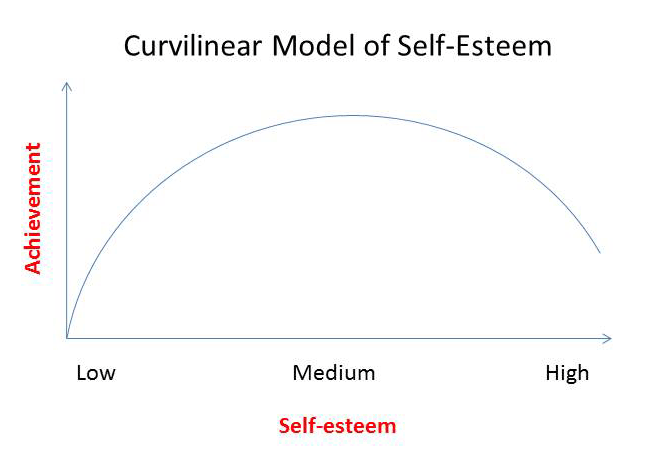On This Page:
Self-esteem should be viewed as a continuum and can be high, medium, or low, and it is often quantified as a number in empirical research.
When considering self-esteem, it is important to note that both high and low levels can be emotionally and socially harmful to the individual. Indeed it is thought an optimum level of self-esteem lies in the middle of the continuum. Individuals operating within this range are thought to be more socially dominant within relationships.

Empirical Research

Research has shown key differences between individuals with high and low self-esteem. For example, people with high self-esteem focus on growth and improvement, whereas people with low self-esteem focus on not making mistakes in life.
Low self-esteem has been shown to be correlated with several negative outcomes, such as depression (Silverstone & Salsali, 2003).
Rosenberg and Owen (2001) offer the following description of low self-esteem people based on empirical research. People with low self-esteem are more troubled by failure and tend to exaggerate events as being negative.
For example, they often interpret non critical comments as critical. They are more likely to experience social anxiety and low levels of interpersonal confidence.
This in turn makes social interaction with others difficult as they feel awkward, shy, conspicuous, and unable to adequately express themselves when interacting with others (p. 409). Furthermore, low self-esteem individuals tend to be pessimistic towards people and groups within society.
Research has also shown that low self-esteem has to linked to an increased risk of teenage pregnancy.
Guindon (2002) asked school counsellors to list five characteristics that best describe students with low self-esteem. Over 1000 words were used and the most common are listed below:
- Withdrawn/shy/quiet
- Insecure
- Underachieving
- Negative (attitude)
- Unhappy
- Socially inept
- Angry/hostile
- Unmotivated
- Depressed
- Dependent/follower
- Poor self-image
- Non-risk-taker
- Lacks self-confidence
- Poor communication
- Acts out
Low Self-Esteem in Children
It should be noted that, on average, self-esteem during childhood is found to be relatively high. However, there are individual differences, and some children are unfortunate to experience feelings of low self-esteem.
Low self-esteem in children tends to be related to physical punishment and the withholding of love and affection by parents. Carl Rogers would describe this as conditional positive regard, whereby individuals only receive positive attention from significant others (such as parents) when they act in a certain way. This reinforces to the child that they are only a person of value when they act a certain way (e.g., achieving A grades on a test).
Children with low self-esteem rely on coping strategies that are counterproductive such as bullying, quitting, cheating, avoiding, etc. Although all children will display some of these behaviors at times, low self-esteem is strongly indicated when these behaviors appear with regularity.
Socially children with low self-esteem can be withdrawn or shy and find it difficult to have fun. Although they may have a wide circle of friends, they are more likely to yield to group pressure and more vulnerable to bullying. At school, they avoid trying new things (for fear of failure) and will give up easily.
Low Self-Esteem in Teenagers
Self-esteem continues to decline during adolescence (particularly for girls). Researchers have explained this decline to body image and other problems associated with puberty.
Although boys and girls report similar levels of self-esteem during childhood, a gender gap emerges by adolescence in that adolescent boys have higher self-esteem than adolescent girls (Robins et al., 2002).
Girls with low self-esteem appear to be more vulnerable to perceptions of the ideal body image perpetuated in western media (through methods such as airbrushing models on magazine covers).
References
Abraham, T. (1988). Toward a Self-Evaluation Maintenance Model of Social behavior. In L. Berkowitz (Ed), Advances in Experimental Social Psychology (pp. 181–227).Academic Press.
Coopersmith, S. (1967). The Antecedents of Self-esteem. Freeman.
Harter, S. 1993. Causes and Consequences of Low Self-esteem in Children and Adolescents. In Baumeister, R.F. (Ed.) Self-Esteem: The Puzzle of Low Self-regard (pp. 87-116).
Mruk, C. (1995). Self-Esteem: Research, Theory, and Practice. Springer.
Guindon, M. H. (2002). Toward Accountability in the Use of the Self‐Esteem Construct. Journal of Counseling & Development, 80(2), 204-214.
Robins, R.W., Trzesniewski, K.H., Tracy, J.L., Gosling, S.D., & Potter, J. (2002). Global self-esteem across the lifespan. Psychology and Aging, 17, 423-434.
Rosenberg, M. (1976). Beyond Self-Esteem: The Neglected Issues in Self-concept Research. Paper presented at the annual meetings of the ASA.
Rosenberg, M. (1979). Conceiving the Self. Basic Books.
Rosenberg, M., & Owens, T.J. (2001). Low self-esteem people: A collective portrait. In T.J. Owens. S. Stryker, & N. Goodmanm (Eds.), Extending self-esteem theory and research (pp. 400-436). New York: Cambridge University Press.
Silverstone, P. H., & Salsali, M. (2003). Low self-esteem and psychiatric patients: Part I–The relationship between low self-esteem and psychiatric diagnosis. Annals of General Psychiatry, 2(1), 2.
Viktor, G. (1982). The Self-Concept. Annual Review of Sociology, 8:1–33.
Viktor, G., & Schwalbe, M.L. (1983). Beyond the Looking-glass Self: Social Structure and Efficacy-Based Self-Esteem. Social Psychology Quarterly, 46:77–88.

